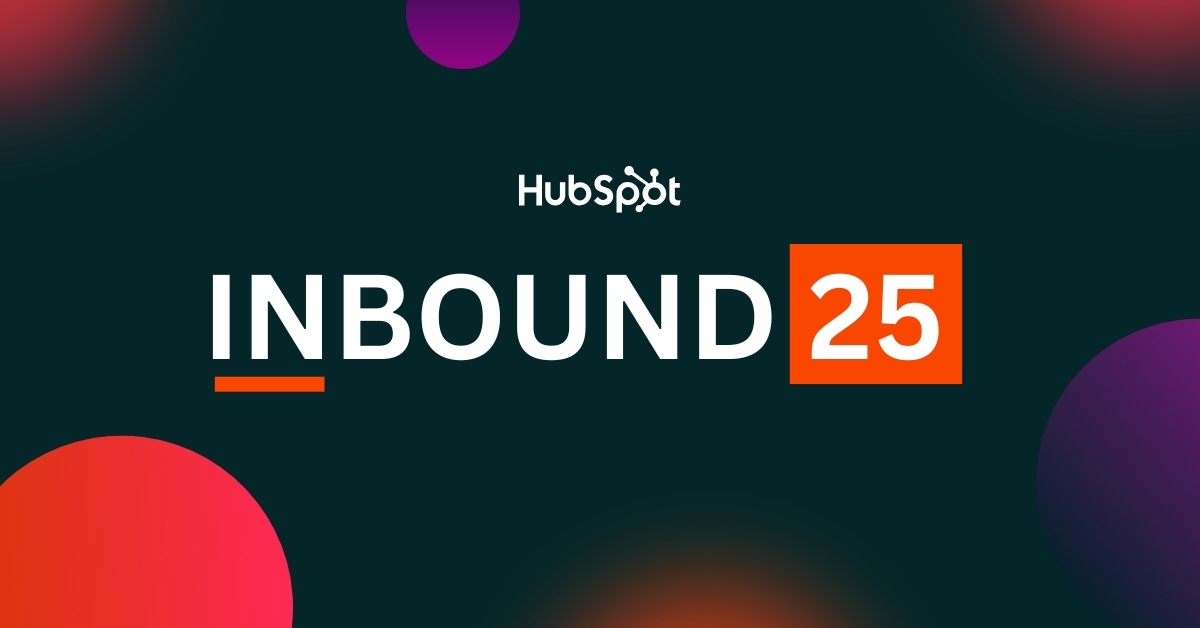HubSpot INBOUND 2025: Complete Guide to Updates & News

Introduction: A Pivotal Year for HubSpot
Every September, marketers, sales leaders, and customer success teams eagerly anticipate one thing: HubSpot’s INBOUND conference. HubSpot’s annual INBOUND conference has always been the stage for big announcements. But INBOUND 2025 feels like a turning point for both HubSpot and the businesses that rely on it.
This year’s theme wasn’t just about new tools. It was about a blueprint for hybrid human-AI teams, featuring over 200 product updates designed to reimagine how marketing, sales, service, and operations can collaborate in an AI-first world.
In today’s time, where we are all part of the Generative AI revolution, we can clearly see the shift in expectations. Today, consumers want speed, intelligence, and personalized engagement. Businesses want productivity, robustness, and belief. HubSpot’s INBOUND 2025 announcements squarely address these needs with innovations around data unification, AI agents, workflow orchestration, and go-to-market frameworks.
In this blog, we’ll dive deep into everything unveiled at INBOUND 2025, what it means for your business, and how to prepare your teams to get the most value. Key topics covered include -
- Data Hub: The Foundation for Trustworthy AI
- Smart CRM Enhancements: Context Where You Need It
- Breeze AI Ecosystem: From Assistants to Agents
- CPQ in Commerce Hub: Speeding Up Deals
- The Loop: Reinventing Marketing Strategy
- Prospecting Agent in Sales Hub: Building Faster Pipelines
1. Data Hub: The Foundation for Trustworthy AI
One of the biggest announcements was the launch of Data Hub, a reimagined version of the former Operations Hub.
What is Data Hub?
%20first%20image.png?width=792&height=380&name=Data%20Hub%20The%20Foundation%20for%20Trustworthy%20AI%20(H2)%20first%20image.png)
.png?width=792&height=389&name=Data%20Hub%20The%20Foundation%20for%20Trustworthy%20AI%20(H2).png)
Data Hub is the main system for managing, cleaning, and unifying data across HubSpot. It unifies structured and unstructured data from CRM, marketing, service, and external sources, such as spreadsheets, data warehouses, and integrations, so that AI agents, reporting dashboards, and teams can work from a single source of truth.
Key Features:
- Data Quality Command Center: A center with robust data tools that automatically find and fix data issues that people spend time resolving (e.g., duplicates, formatting issues, incomplete records).
- Data Studio: Scattered data can be easily transformed into unified datasets with HubSpot’s AI-powered assistance and its familiar spreadsheet-style interface.
- Cloud Data Storage Integrations: Now connect Snowflake, Google BigQuery, or Amazon AWS S3 to HubSpot without requiring any complex builds.
Why It Matters:
AI without good data is dangerous. Many GenAI projects fail because data is broken, unreliable, or fragmented. By investing in Data Hub, HubSpot is providing a unified database that is the starting point for every AI-driven workflow.
2. Smart CRM Enhancements: Context Where You Need It
HubSpot’s Smart CRM got major upgrades to make it more flexible and insight-driven.
Key Enhancements:
- Flexible CRM Views: Teams can now design CRM views tailored to their workflows. A sales representative might view pipeline charts, while a service manager sees open tickets on a Kanban-style board.
- Conversational & Intent Enrichment: HubSpot can now automatically review your emails, calls, and meeting transcripts to identify key intent signals and update your CRM for you. With conversational enrichment and smart properties, it takes care of the research and keeps your CRM up to date, requiring no manual work.
- Smart Insights: Smart Insights looks at your CRM data and highlights what really matters as to what's changed, why it’s important, and what actions you should take next.
Why It Matters:
Traditionally, CRMs have been criticized as “glorified databases.” These updates make HubSpot a more dynamic system of insights—reducing the time teams spend searching for information and providing them with the context they need to act quickly.
3. Breeze AI Ecosystem: From Assistants to Agents
Perhaps the most exciting announcement was Breeze. HubSpot relaunched and expanded its AI tools under the Breeze umbrella.
The Breeze Components:
- Breeze Agents: AI agents designed for specific functions across Marketing, Sales, and Service.
- Data Agent: HubSpot Data Agent is an AI assistant that pulls info from your CRM, conversations, documents, and the web to give insights on customers, competitors, and trends. It auto-updates Smart Properties and workflows, saving you from manual research and data entry.

- Customer Agent: HubSpot Customer Agent is an AI support tool that handles customer queries 24/7 across chat, email, and social channels. It uses your company info to give smart responses and routes complex issues to the right team, reducing manual workload.

- Prospecting Agent: HubSpot Prospecting Agent is an AI-powered tool that supports sales teams in researching leads, crafting personalized emails, and automating follow-ups. It pulls data from your CRM and the web, saving time and effort.

- Breeze Assistant (formerly Copilot): Breeze Assistants are AI helpers in HubSpot that use your CRM data and content to help you draft emails, blog posts, summaries, and do lead research. They make marketing, sales, and support work more efficiently and effectively.
.png?width=752&height=362&name=Breeze%20Assistant%20(formerly%20Copilot).png)
- Breeze Studio: Breeze Studio is a no-code tool in HubSpot that lets you build custom AI assistants for tasks like sales, support, or research. Just add your content and instructions and it learns and works like a personalized helper for your business.

- Breeze Marketplace: Breeze Marketplace is HubSpot’s app store for AI assistants, where you can find and install ready-made tools to simplify sales, marketing, and support tasks.

Why It Matters:
Instead of a single generic AI assistant, HubSpot is building a comprehensive ecosystem of specialized agents that can operate autonomously or semi-autonomously throughout the customer journey.
This is a big step toward “agentic AI”—AI that isn’t just a helper but an active participant in your workflows.
4. CPQ in Commerce Hub: Speeding Up Deals
HubSpot has doubled down on Commerce Hub with AI-powered Configure-Price-Quote (CPQ) capabilities.
Key Features:
- Automated Quote Generation: Based on conversation data and deal context, HubSpot can draft personalized quotes.
- Closing Agent:. The Closing Agent, powered by Breeze. HubSpot's AI, uses contextual files to answer buyers' questions about your quote. It will be enabled by default, allowing buyers to ask questions while viewing the quote.
- Product Builder: Configure bundles, discounts, and tiered pricing, simplifying product management and pricing from a unified platform.
- Approval Workflows: Automatically route quotes to managers for approval. Set simple rules or logic-based approvals using Workflows.
- Quote Engagement Tracking: Get notified when a prospect opens, shares, or comments on a quote via the quote activity log.
Why It Matters:
Slow quotes kill deals. By making CPQ smarter and faster, HubSpot helps teams shorten sales cycles and reduce bottlenecks.
5. The Loop: Reinventing Marketing Strategy
HubSpot introduced a new marketing framework called The Loop.

The Four Stages:
1. Express – Launch quickly with a core message. AI can create content in just a few seconds but to ensure it matches your brand voice you need to guide AI with clear instructions like -
- Creating Ideal Customer Profile (ICP)
- Crafting style guide
- Geneating Campaign Concepts
2. Tailor – Personalize based on audience data and signals. To gain your buyer’s trust and have an edge, make them feel seen and understood by -
- Enriching data
- Segementation
- Personalizing Content
- Quality Checking
3. Amplify – Scale what works to new segments and channels. Today’s customers are all over - ChatGPT, YouTube, Reddit, Quora, G2. Make sure you are omnipresent by -
- Planning Content Strategy
- Optimize for all platforms
- Present in multiple formats (carousel, video, Infographic, etc)
- Ads Targeting
4. Evolve – Adjust continuously as feedback and results come in. The new era of marketing is all about speed by -
- Monitoring real-time performance
- Continuous optimizations
- Run A/B Tests
Why It Matters:
Traditional funnel-based marketing assumes linear buyer journeys. The Loop acknowledges reality: customer journeys are messy, iterative, and data-driven.
6. Prospecting Agent in Sales Hub: Building Faster Pipelines

The Prospecting Agent is HubSpot’s AI-powered Business Development Representative (BDR). It assists with lead research, outreach, and pipeline building.
- Smart Research - Gathers intel on leads from CRM + external signals
- Personalized Outreach - Crafts personalized outreach emails in your voice, sends emails when buying signals are detected, either automatically or after review by a Sales rep.
- Guardrails - The agent can work automatically or after a sales rep review
Why It Matters:
Sales representatives traditionally spend more time on administrative work and less time selling. The Prospecting agent can help find and connect with leads, draft emails, and log automatically, without manual effort.
Why These Updates Matter: The Bigger Picture
If there’s one thread running through INBOUND 2025, it’s trust + scale + simplicity.
- Trust: Data Hub and governance tools ensure AI doesn’t run on bad data.
- Scale: Breeze agents and CPQ streamline repetitive tasks, helping teams do more with less.
- Simplicity: HubSpot continues to prioritize usability, even as it adds enterprise features.
For businesses, this means HubSpot can now serve as the single platform to manage marketing, sales, service, and data operations, powered by AI.
Conclusion: HubSpot’s Renaissance Moment
INBOUND 2025 wasn’t about incremental updates. It was about redefining HubSpot’s role in the age of AI.
With Data Hub, Smart CRM, Breeze Agents, CPQ, and The Loop, HubSpot offers businesses a front-office platform that is both simple enough for SMBs and powerful enough for enterprises.
HubSpot is no longer just a marketing tool, it’s becoming the operating system for the modern customer journey.

Puja is an artistic, creative, and passionate Client Success Manager at Inboundsys. She has more than 15 years of experience in web designing and the Ed-Tech platform. Over the years, she has essayed multiple roles, from being a web designer, content writer, teacher, and business analyst to a quality analyst. She has exceptional analytical skills, interpersonal communication skills, and organizational skills. Her keen ability to break down and synthesize information and attention to detail while envisioning the bigger picture makes her a genuine people person and build healthy relationships. She is an eloquent writer and has written many blogs on Ed-Tech and other web technologies. During her free time, she likes reading books on recent technological developments and non–fiction books and satiate her creative instincts through painting and cooking.